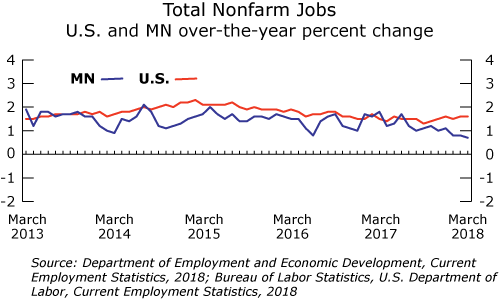by Nick Dobbins
April 2018
Monthly analysis is based on unadjusted employment data.
Employment in the Minneapolis-St. Paul MSA was up by 4,252 (0.2 percent) in March, which is in line with traditional employment growth for the month. The largest proportional growth came in Leisure and Hospitality, up 1.1 percent (1,923 jobs) as employers began spring hiring in Accommodation and Food Services industries. Manufacturers added 1,597 jobs (0.8 percent), with most of that growth coming among Durable Goods Manufacturers (up 1,328 or 1 percent). Government employers shed 1,488 jobs (0.6 percent). Over the year metro area employers added 16,455 jobs. Notable growth occurred in a number of supersectors, including Educational and Health Services (up 6,604, 2 percent), Government (up 6036, 2.4 percent), and Trade, Transportation, and Utilities (up 6,690, 1.9 percent). The largest numerical decline came in Professional and Business Services, which was off by 4,064 jobs (1.3 percent), while the largest proportional decline came in Mining, Logging, and Construction, which was off by 2.3 percent, 1,659 jobs.
The Duluth-Superior MSA lost 429 jobs (0.3 percent) in March, which is slightly out of line with the small gains seen in statewide and Twin Cities employment, but common for Duluth, where employment generally doesn’t show its spring growth until April. Trade, Transportation, and Utilities had the most losses, both proportionally and in real jobs, off by 227 or 0.9 percent. All of the losses came from the Transportation, Warehousing, and Utilities component sector. Annually the Duluth MSA added 1,404 jobs (1 percent). Mining, Logging, and Construction employment was up by 256 (3.2 percent), and Manufacturing was up 168 (2.3 percent). The largest proportional decline came in the already-tiny Information supersector, which suffered a 5.5 percent decline from last March, losing 77 jobs. Professional and Business Services lost the most jobs, off by 101 or 1.3 percent.
The Rochester MSA added 489 jobs (0.4 percent) in March. Manufacturing employers added 128 jobs (1.3 percent), and Government employers added 175 (1.3 percent). The largest proportional increase came in Professional and Business Services, up 2 percent or 102 jobs. The largest proportional decline was in Financial Activities, which was off by 0.3 percent or 7 jobs. Annually the MSA added 70 jobs or just 0.1 percent. It was the lowest over-the-year growth of any MSA in the state. Losses in Mining, Logging, and Construction (down 123 jobs or 3.1 percent) and Educational and Health Services (down 856 or 1.7 percent) held annual job growth down in the area. The largest increase came in Leisure and Hospitality, which added 618 jobs or 6.1 percent.
The Saint Cloud MSA added 427 jobs (0.4 percent) in March, slightly outpacing statewide over-the-month growth. Mining, Logging, and Construction added 188 jobs (3.3 percent), the largest growth rate of any supersector in the MSA, during a month when statewide employment in the supersector declined by 0.9 percent. Manufacturing also showed notable growth, adding 270 jobs (1.8 percent). Annually the Saint Cloud MSA added 693 jobs (0.6 percent). Manufacturing employers led the way, adding 688 jobs (4.6 percent), along with Educational and Health Services, which added 804 (3.7 percent). The sharpest decline came in Leisure and Hospitality, which was off by 6.2 percent or 558 jobs. Mining, Logging, and Construction employment was off by 223 (3.7 percent) on the year, while Trade, Transportation, and Utilities lost 370 jobs (1.7 percent).
Employment in the Mankato-North Mankato MSA was off by 154 jobs or 0.3 percent on an unadjusted basis in March. Employment in goods production grew by 0.6 percent (62 jobs) but that small amount of growth was swamped by the loss of 216 jobs (0.4 percent) among service providers. Private and public-sector employers lost jobs in March. Annually the Mankato area added 1,278 jobs (2.2 percent), the largest over-the-year growth rate of any MSA in Minnesota. Service providers added 949 jobs (2 percent), and goods producers added 329 (3.4 percent). Most of the annual growth came in the private sector, which added 1,209 jobs or 2.5 percent, although public sector employment was also up on the year.
The Fargo-Moorhead MSA’s employment was mostly flat in March as the area added 30 jobs (0 percent). Gains in Mining, Logging, and Construction (up 209 or 2.8 percent) and Professional and Business Services (up 237 or 1.6 percent) were countered by similarly-sized losses in Government (down 283 or 1.4 percent) and Trade, Transportation, and Utilities (down 342, 1.1 percent). Annually the Fargo-Moorhead area added 654 jobs (0.5 percent). Educational and Health Services added 821 jobs (3.4 percent), and Manufacturing added 306 (3.2 percent). Trade, Transportation, and Utilities lost 339 (1.1 percent), and Leisure and Hospitality lost 285 (2.1 percent).
The Grand Forks-East Grand Forks MSA lost 78 jobs (0.1 percent) in March. The only supersector to gain or lose more than 100 jobs was Trade, Transportation, and Utilities (down 164, 1.4 percent). The only other supersector with movement of more than 1 percent was Information, which lost 1.4 percent (8 jobs). Annually the MSA lost 772 jobs (1.4 percent). Once again, it was the only MSA with negative over-the-year job growth. The primary culprit remained a significant loss in Leisure and Hospitality, which was off by 822 jobs (13 percent).
